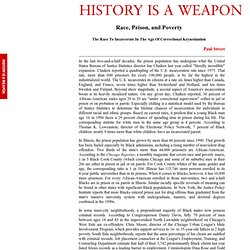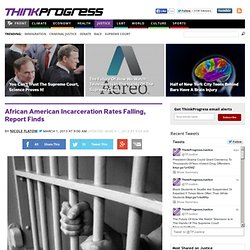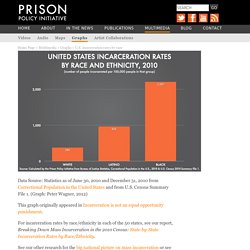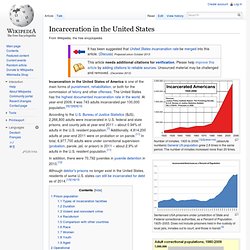

Race, Prison, and Poverty. The Race To Incarcerate In The Age Of Correctional Keynesianism Paul Street In the last two-and-a-half decades, the prison population has undergone what the United States Bureau of Justice Statistics director Jan Chaiken last year called "literally incredible" expansion.

Chaiken reported a quadrupling of the U.S. incarceration rate since 1975. African American Incarceration Rates Falling, Report Finds. By Nicole Flatow "African American Incarceration Rates Falling, Report Finds"

U.S. Has World's Highest Incarceration Rate. (August 2012) Since 2002, the United States has had the highest incarceration rate in the world.

Although prison populations are increasing in some parts of the world, the natural rate of incarceration for countries comparable to the United States tends to stay around 100 prisoners per 100,000 population. The U.S. rate is 500 prisoners per 100,000 residents, or about 1.6 million prisoners in 2010, according to the latest available data from the Bureau of Justice Statistics (BJS).1 Men make up 90 percent of the prison and local jail population, and they have an imprisonment rate 14 times higher than the rate for women.2 And these men are overwhelmingly young: Incarceration rates are highest for those in their 20s and early 30s.
Prisoners also tend to be less educated: The average state prisoner has a 10th grade education, and about 70 percent have not completed high school.3 Incarceration rates are significantly higher for blacks and Latinos than for whites. References. U.S. incarceration rates by race. Data Source: Statistics as of June 30, 2010 and December 31, 2010 from Correctional Population in the United States and from U.S.

Census Summary File 1. (Graph: Peter Wagner, 2012) This graph originally appeared in Incarceration is not an equal opportunity punishment. Rd_stateratesofincbyraceandethnicity. Malware Labs. Incarceration in the United States. Sentenced USA prisoners under jurisdiction of State and Federal correctional authorities, as a Percent of Population. 1925–2003.

Does not include prisoners held in the custody of local jails, inmates out to court, and those in transit.[3] 6,977,700 adults were under correctional supervision (probation, parole, jail, or prison) in 2009.[4][5] A graph showing the incarceration rate under state and federal jurisdiction per 100,000 population 1925–2008. Does not include prisoners held in the custody of local jails, inmates out to court, and those in transit.[3] The male incarceration rate is roughly 15 times the female incarceration rate. Inmates held in custody in state or federal prisons or in local jails, December 31, 2000, and 2009–2010.[6] According to the U.S. In addition, there were 70,792 juveniles in juvenile detention in 2010.[12] Although debtor's prisons no longer exist in the United States, residents of some U.S. states can still be incarcerated for debt as of 2014.[13][14][15] Incarceration-2010-06.
Mass Incarceration and Criminal Justice in America. A prison is a trap for catching time.

Good reporting appears often about the inner life of the American prison, but the catch is that American prison life is mostly undramatic—the reported stories fail to grab us, because, for the most part, nothing happens. One day in the life of Ivan Denisovich is all you need to know about Ivan Denisovich, because the idea that anyone could live for a minute in such circumstances seems impossible; one day in the life of an American prison means much less, because the force of it is that one day typically stretches out for decades. It isn’t the horror of the time at hand but the unimaginable sameness of the time ahead that makes prisons unendurable for their inmates. The inmates on death row in Texas are called men in “timeless time,” because they alone aren’t serving time: they aren’t waiting out five years or a decade or a lifetime. The Sentencing Project News - Incarceration. “Felon voting” sounds ominous but in Minnesota, it poses a potent political and civil rights question: When should felons who are trying to rebuild their lives regain their right to vote?

People convicted of a felony lose that right as part of their punishment. The Minnesota Constitution denies the right to “a person convicted of treason or felony, unless restored to civil rights.” The Top 10 Most Startling Facts About People of Color and Criminal Justice in the United States. SOURCE: AP/ California Department of Corrections Eliminating the racial disparities inherent to our nation’s criminal-justice policies and practices must be at the heart of a renewed, refocused, and reenergized movement for racial justice in America.

By Sophia Kerby | March 13, 2012 This month the United States celebrates the Selma-to-Montgomery marches of 1965 to commemorate our shared history of the civil rights movement and our nation’s continued progress towards racial equality. Yet decades later a broken criminal-justice system has proven that we still have a long way to go in achieving racial equality. Today people of color continue to be disproportionately incarcerated, policed, and sentenced to death at significantly higher rates than their white counterparts. Below we outline the top 10 facts pertaining to the criminal-justice system’s impact on communities of color. 1. 2. 3.